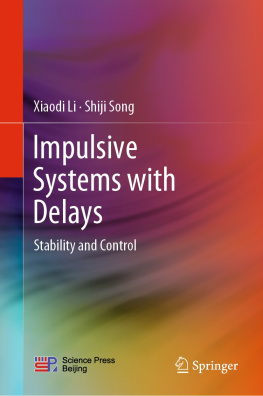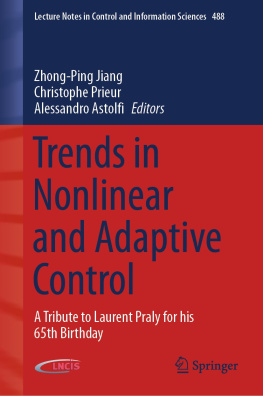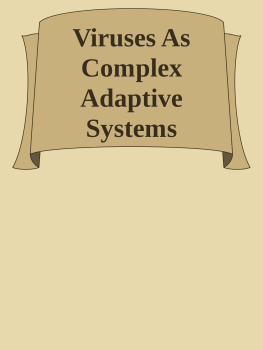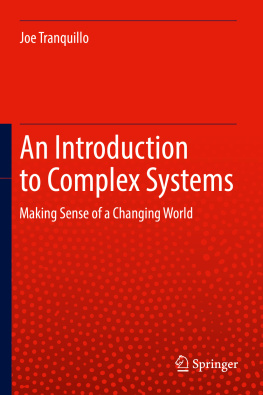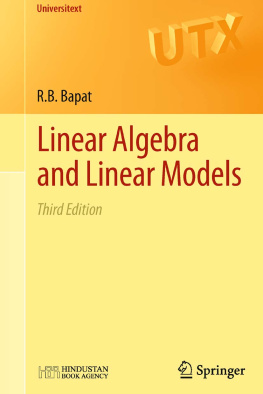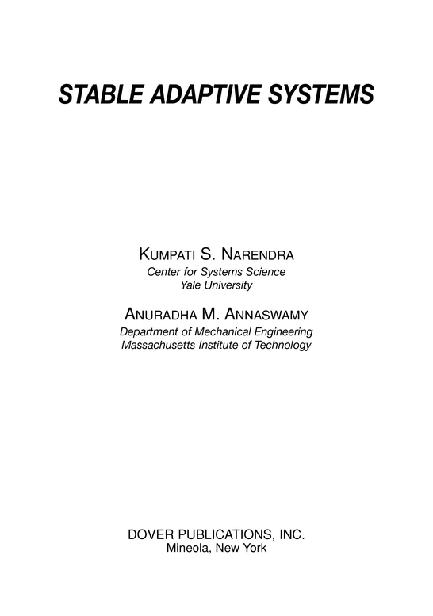
Copyright
Copyright 1989 by Kumpati S. Narendra and Anuradha M. Annaswamy
All rights reserved.
Bibliographical Note
This Dover edition, first published in 2005, is an unabridged republication of the work originally published in 1989 by Prentice-Hall, Inc., Englewood Cliffs, New Jersey, as part of the Information and System Sciences series. An errata list (pages 495 496) has been added to the present edition.
Library of Congress Cataloging-in-Publication Data
Narendra, Kumpati S.
Stable adaptive systems / Kumpati S. Narendra, Anuradha M. Annaswamy.
p. cm.
Originally published: Englewood Cliffs, N.J. : Prentice Hall, c1989.
Includes bibliographical references and index.
9780486141428
1. Adaptive control systems. I. Annaswamy, Anuradha M., 1956 II. Title.
TJ217.N37 2005
629.836 dc22
2004065741
Manufactured in the United States of America
Dover Publications, Inc., 31 East 2nd Street, Mineola, N.Y 11501
To the memory of my mentor, Philippe LeCorbeiller,
and
to my graduate students
K.S.N.
To my grandfather, Pandit Narayan Jayaram Sharma
A.M.A.
Table of Contents
Preface
This is an exciting time to be working in the field of adaptive control. Research in recent years has led to the emergence of a wide spectrum of problems and the field is sufficiently mature to attract theoreticians looking for an area in which nonlinear systems arise naturally. In addition, the adaptive algorithms being studied complement current computing technology resulting in a powerful approach with great potential impact on the world of applications. Sophisticated, yet practical, adaptive controllers are now feasible. For these reasons, it is not surprising that adaptive control has found a large following in all segments of the control community as a whole.
Three decades after the term adaptation was introduced into the engineering literature, it is now generally realized that adaptive systems are special classes of nonlinear systems and hence capable of exhibiting behavior not encountered in linear systems. The difficulty experienced in coming up with a universally acceptable definition of adaptive systems, as well as in generating techniques for their analysis and synthesis, may be traced ultimately to this fact. It is well known that design techniques for dynamical systems are closely related to their stability properties. Since necessary and sufficient conditions for the stability of linear systems have been developed over the past century, it is not surprising that well known design methods have been established for such systems. In contrast to this, general methods for the analysis and synthesis of nonlinear systems do not exist since conditions for their stability can be established only on a system by system basis. To design tractable synthesis procedures, adaptive systems are structured in such a fashion that their behavior asymptotically approaches that of linear systems. The central theme of this book is stability of adaptive systems, and it is based on the conviction that adaptive systems can be designed with confidence only when their global stability properties are well understood.
In 1980, the stability problem of an idealized version of an adaptive system was resolved and it has come to represent a landmark in the development of adaptive systems. Following this, in recent years, a multiplicity of ideas have been generated in the field. The flood of new information is so great that the beginner tends to be overwhelmed by the numerous techniques and perspectives adopted. The time appears to be appropriate to attempt a unified presentation of results that are currently well known and to establish the close connections that exist between seemingly independent developments in the field.
The entire book is written in a self-contained fashion and is meant to serve as a text book on adaptive systems at the senior undergraduate or first-year graduate level. A knowledge of linear algebra and differential equations as well as an acquaintance with basic concepts in linear systems theory is assumed. The book can be used for an intensive one-semester course, or a two-semester course with emphasis on recent research in the second semester. The problems included at the end of the chapters should be considered as an integral part of the book. Following the approach used by the authors while teaching this course at Yale, the problems are divided into three categories I, II, and III. Problems in Part I are relatively easy and are meant primarily to test the students knowledge of mathematical prerequisites and systems concepts. Part II contains problems that can be solved by the application of results derived in the chapters. Problems in Part III are substantially more difficult and occasionally include open questions in adaptive control for which solutions are not currently available.
The book is arranged in such a manner that Chapters 1-7 are accessible to the beginner while Chapters 8-11 are meant for the more advanced, research-oriented student. A fairly extensive first chapter sets the tone for the entire book. Besides introducing basic concepts, it also attempts to trace the evolution of the field to its present state from early approaches that were popular in the 1960s. In particular, an effort has been made to delineate clearly the basis for many of the assumptions that are made in the following chapters which are generally scattered in the technical literature. The authors believe that the importance of these ideas for a broad understanding of the field justifies the unusual length of the introduction. Chapter 2 is devoted to a discussion of results in stability theory with emphasis on those results which are directly relevant to the study of adaptive systems. While Chapters 3-5 deal with the stability properties of adaptive observers and controllers, Chapter 6 introduces the important concept of persistent excitation. In Chapter 7 it is shown that all the systems discussed in Chapters 3-6 can be analyzed in a unified fashion using error models. Chapters 8-10 deal with areas where there has been intense research activity in the last eight years and the final chapter contains five detailed case studies of systems where adaptive control has proved successful.
Developments in the field of adaptive control have proceeded in a parallel fashion in both discrete and continuous systems, and results in one area usually have counterparts in the other. Many of the problems formulated using discrete or continuous time models can also be studied in the presence of stochastic disturbances. This book deals with continuous time finite dimensional deterministic systems. We believe that a thorough understanding of this class will provide the essential foundation for establishing analogous results in both the discrete time and stochastic cases.
It is our privilege to thank a long list of friends and colleagues who have helped us in the preparation of the book in different ways. We are especially grateful to Petar Kokotovic for his careful scrutiny of the first seven chapters and numerous valuable suggestions. We would also like to thank Peter Dorato, Petros Ioannou, Robert Kosut, Gerhard Kreisselmeier, Steve Morse, and R.P. Singh for their comments on portions of the manuscript and to Job van Amerongen, Dan Koditschek, Heinz Unbehauen, and Eric Ydstie for critically evaluating parts of Chapter 11. Manuel Duarte and Jovan Boskovic took part in numerous technical discussions and Jovans help in collecting the material for Chapter 11 is particularly appreciated. Both of them worked very hard toward proofreading the final manuscript. We are most grateful to them for their commitment to the completion of the book. Finally, we would like to thank Eileen Bernadette Moran for encouraging us to do this project with Prentice Hall, Tim Bozik, engineering editor, for his enthusiasm and help, and Sophie Papanikolaou, production editor, for her remarkable efficiency.
Next page

